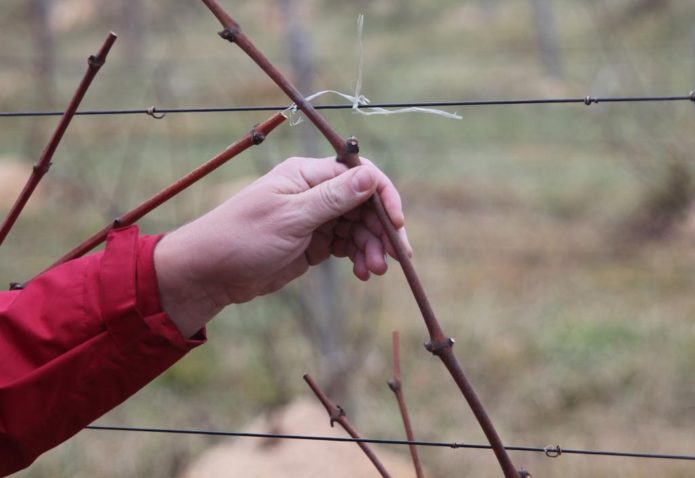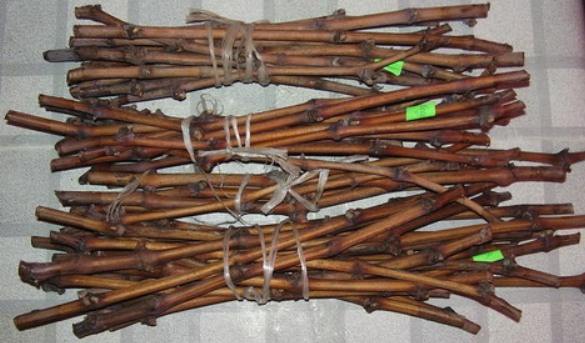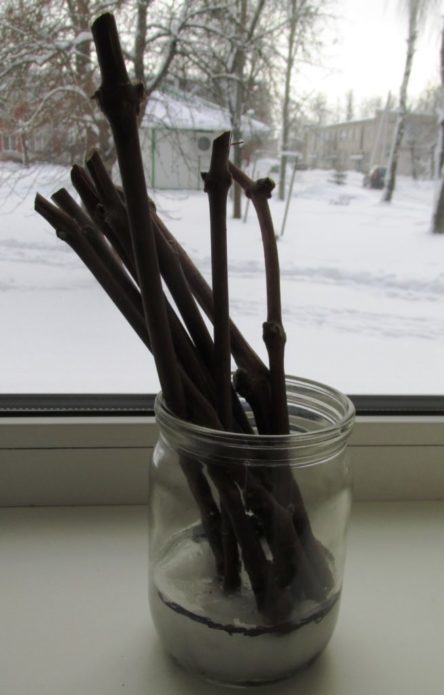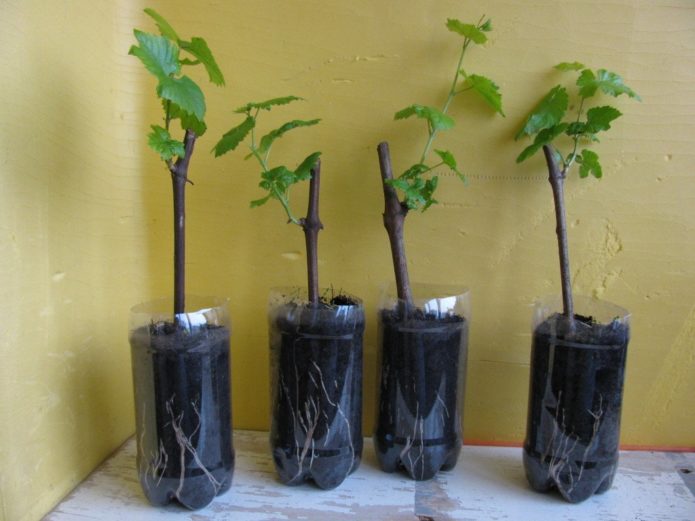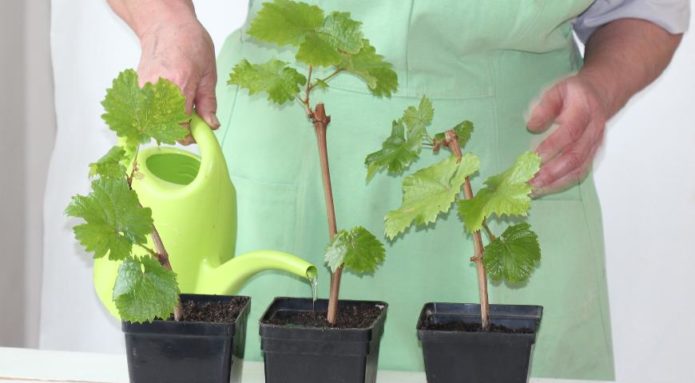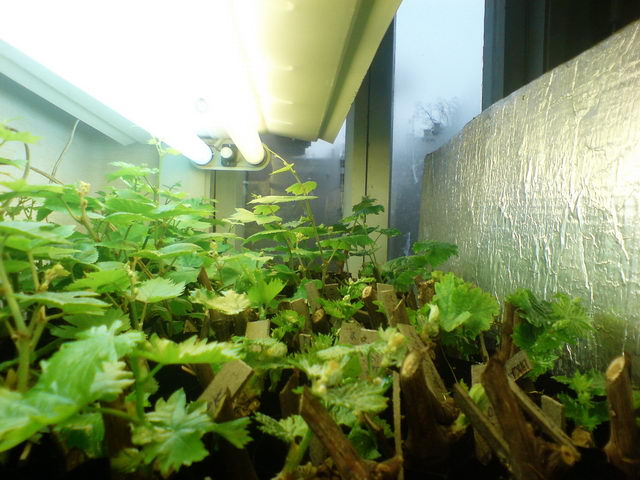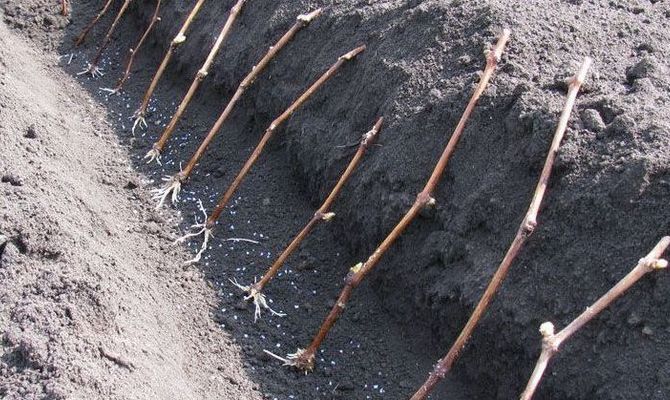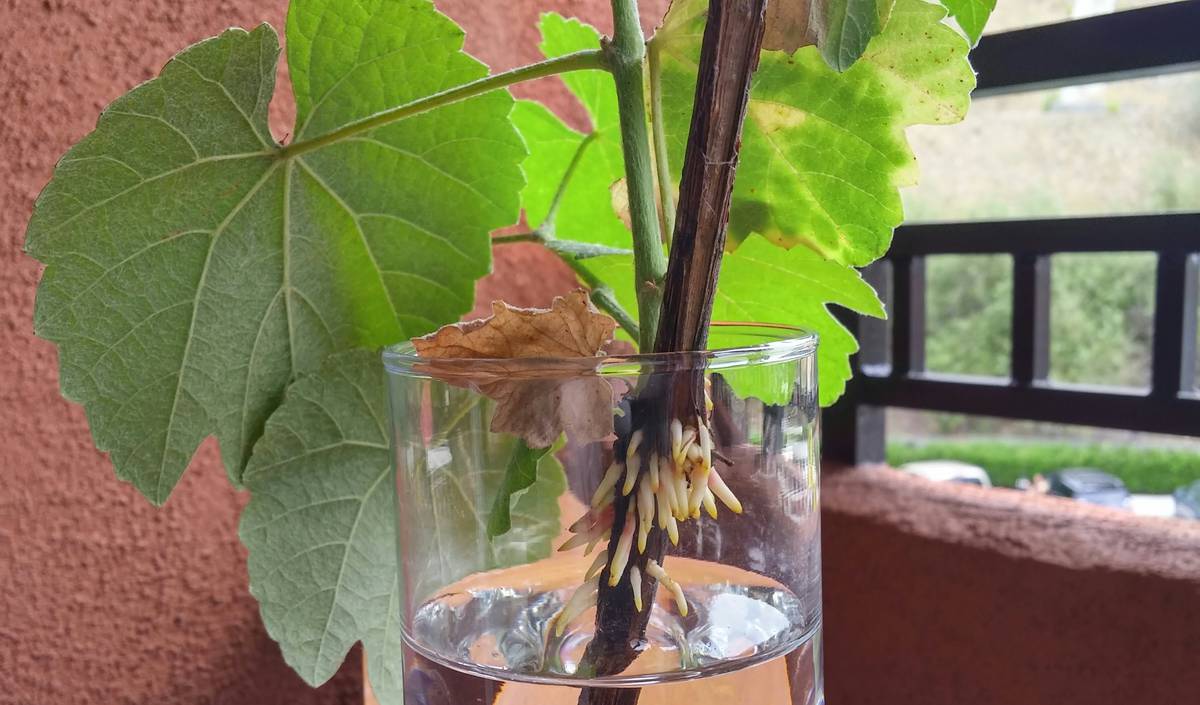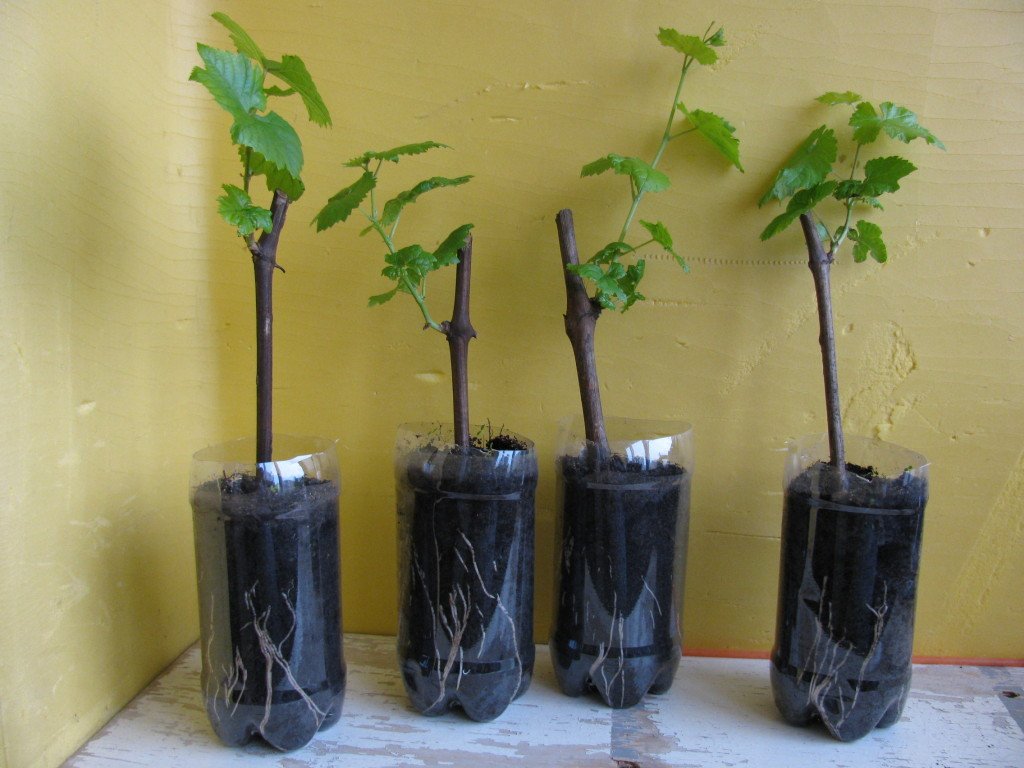Rooting lignified cuttings is the main method of grape propagation, available even to a novice gardener. The principles of growing seedlings from cuttings differ slightly depending on the region and have many options, but the success of obtaining high-quality seedlings, subject to simple rules, is guaranteed. You just need to get some cuttings of the variety you like and be patient.
Content
Harvesting grape cuttings in autumn
The time when in the fall it is already possible to cut grape cuttings for early spring or even winter planting for germination comes when the leaves begin to turn yellow. During this period, they can be cut off, and after a week, cuttings can be cut. However, you should not rush, since it is much more convenient to do this in late autumn, during the main pruning of bushes before sheltering for the winter. By that time, the leaves will be gone, the unripe vine fragments will freeze from the first mild frosts, and everything will be "in full view." Leaving the harvesting of cuttings in the spring is not worth it: who knows what will happen to the vine in winter?
Often the top of the vine does not have time to ripen during the summer period, and it must be removed. Actually, after the first frost it is perfectly visible. A well-ripened vine crackles when bent. It is advisable only to have time with cutting before temperatures below -5 aboutC. In the fall, cuttings should be cut longer than they are required for planting, with 5-6 buds, since in the spring they will again need to be cut on both sides. The best shoots for grafting are at least 5 mm in diameter, from the middle of a vine that has grown to at least one and a half meters in length. Thin cuttings will also take root, but the process will go slower, the seedlings will not grow so strong.
If this first and simple operation is not performed correctly, further work may be useless. The most common errors are:
- cutting too thin cuttings;
- cuttings are not taken from the middle of the vine: it is the areas from the middle of the shoot that are better stored, they have the most developed buds;
- cutting is done early: the vine ripens until the very frost, and there is no need to rush with this procedure.
How to propagate grapes by cuttings, how to do it right at home:https://flowers.bigbadmole.com/en/yagody/vinograd/kak-razmnozhit-vinograd-cherenkami.html
Storage of planting material before planting in the ground
To preserve the cuttings until winter, you need a cellar or shelf in your home refrigerator. They will have to lie there until about mid-February, the optimum temperature is about +1 aboutFROM.
Before sending to the cellar, the cuttings must be prepared. This will require:
- Treat with a chemical to destroy possible disease spores: you can use iron or copper sulfate (1% solution) or Chinosol (0.5%), soaking for a couple of hours.
- Soak for 1-2 days in water, so that they do not dry out too much during storage.
- Air dry until clear drops are removed (you can simply wipe off with a cloth).
- Put in a plastic bag, leaving only the tops of a few centimeters long outside, and tie.
- Do not forget to sign the package.
If possible, not "naked" cuttings are put into the bag. It is useful to overlay them with pine or spruce sawdust, but first, the sawdust must be scalded with boiling water. Coniferous resin has a beneficial effect on the safety of cuttings, protecting them from accidental mold. During the winter, the sawdust should be changed once or twice. At the same time, carefully examine the cuttings for their suitability, throwing out the clearly blackened ones.
The maximum possible storage temperature for cuttings is 6-7 aboutC. Air humidity should be slightly less than 100%. Periodically, a revision of the planting material is required: if even traces of mold are found, the cuttings should be wiped off and washed with a pink solution of potassium permanganate. If drying is found, soak for several hours (if necessary, up to a day) in water and send it back to the cold.
Germination of grape cuttings
In most regions of our country, work with cuttings put in storage in the fall begins at the end of winter. First, they must be prepared for later life, it will be difficult in any case. To begin with, cuttings you need:
- Unpack.
- Rinse in a dark solution of potassium permanganate.
- Rinse with clean water.
- Dry slightly.
Perhaps not everyone survived the winter well, so you need to check their survivability. If you lightly scrape off the bark of a live cutting, a green tissue should appear underneath. A brown, yellow or black color suggests that such a cutting will have to be thrown away.
Now from the long stocked cuttings it is necessary to cut those that we will plant. Short cuttings for certain grape planting schemes should have three healthy kidneys (two are possible, if they are well developed, then that's enough). Grape cuttings with three developed buds are traditionally called shanks. Cuttings with a large number of buds will give many roots, which is not very convenient when growing at home.
The upper cut should be straight and 2–3 cm above the kidney, the lower one (1–2 cm under the kidney) is made obliquely.
In any case, the prepared cuttings should swim in the water for 2-3 days (better - from the melted snow), and you must be sure that this time is enough. The signal is the release of moisture droplets on the cut of the cuttings taken out of the water. Sometimes this takes longer.
Then options are possible. There are two of them:
- the most experienced and risky growers plant soaked cuttings in a container with soil just like that, without roots, and with careful implementation of all subsequent procedures, they get good results;
- for insurance, the cuttings are first forced to put in the roots and only then, with the roots, they are planted in pots or cups with soil.
But in any case, 3-4 longitudinal shallow grooves must be made with a knife or a needle at the bottom of the soaked cuttings. This facilitates the growth of a more powerful root system. Some amateurs use various rooting stimulants, but this must be done strictly according to the instructions, and good cuttings take root even without their use. A honey solution can serve as a natural stimulant: a tablespoon per liter of water. Of course, success may also depend on the grape variety: there are varieties that are difficult to root.
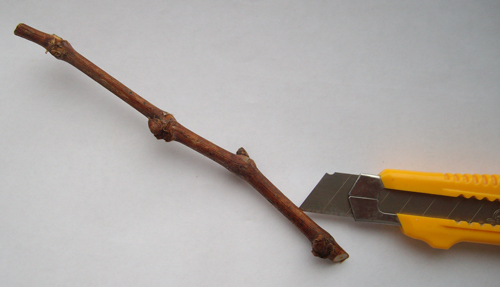
You can apply shallow scratches with any convenient tool, this will greatly facilitate the formation of roots for cuttings
So, let's say you decided that you will plant cuttings in the ground only after they have given roots. How to germinate cuttings, awaken them and force them to form roots? There are also several options here, but one of them is completely elementary. To germinate cuttings you need:
- Take a liter glass jar or a cut-off plastic bottle, pour boiled water into it in a layer of 4–5 cm.
- Put two tablets of activated carbon into the water to prevent and disinfect water.
- Cover the cuttings with the top cut with garden varnish or plasticine.
- Place the cuttings in the jar.
- Put the jar on the battery so that the temperature of the future roots is higher than that of the tops of the cuttings; the temperature should be adjusted with the supports under the jar, optimally - from 25 to 30 aboutFROM.
- Constantly monitor the water level: it should almost not fluctuate, it is at the air / water border that roots should appear;
- The water should be changed for the first few days.
- After two weeks, you should wait for the awakening of the kidneys, and after another ten days - the appearance of white roots.
- As soon as the roots reach a length of 2.5–3 cm, the process must be stopped, the cuttings must be removed from the water and planted in the ground.
A slightly more complicated option is to use scalded coniferous sawdust instead of water. They are also poured in a layer of 4–5 cm, moistened with water, cuttings are placed on them and the same amount of sawdust is added. Sawdust is sometimes replaced with ordinary cotton wool. The option in which the cuttings wrapped in a wet rag are tightly tied in a plastic bag, leaving only the upper kidney outside, apparently, is not worth recommending: in the bag, both souring of water and breaking off of emerging roots are possible.
Secrets of successfully planting grapes with cuttings:https://flowers.bigbadmole.com/en/yagody/vinograd/posadka-vinograda-cherenkami-vesnoy.html
Video: germinating grape cuttings in water
Planting grape cuttings at home in cups or pots
So, in a container with soil, you can plant both cuttings that have already given roots, and simply soaked cuttings. There is a slight difference in planting technique and soil selection.
Planting germinated cuttings
If we plant cuttings with roots, it means that they already have very small green leaves. If three weeks have passed, there are leaves, but there are no roots yet, this does not mean that everything is lost: for some grape varieties this situation is normal, and you have to wait a little longer, freshening the water or replacing sawdust. Cuttings that have taken root can be planted in pots or large glasses.
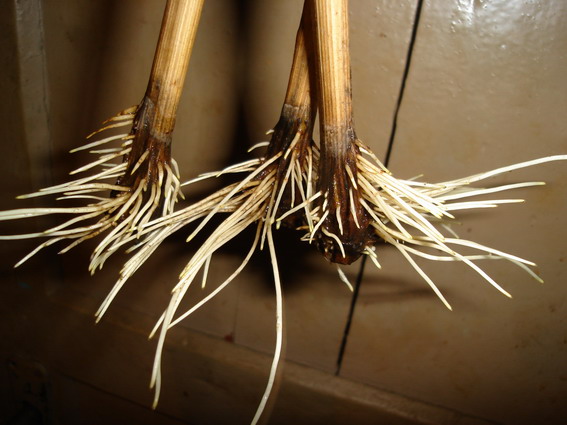
The optimal length of the roots is from 2 to 4 cm, but when planting them, you must try not to break off
To grow grape seedlings from cuttings, it is convenient to use large paper cups or one and a half liter plastic bottles, cutting off their tapering top and making several holes in the bottom to drain excess water with a hot nail. At the bottom of any vessel, it is imperative to lay 3-4 cm of drainage from fine pebbles or coarse sand. Soil is a mixture of equal amounts of fertile land and river sand.
One cuttings are planted in each container. It is possible and two at a time, if there are a lot of them, and there is not enough space, but then the worst will have to be removed: it is possible to grow two seedlings in one bottle, but it will be cramped for them, and it will be impossible to plant them later in open ground without disturbing the root system.
If the stalk had three buds, it must be planted so that one is in the ground, the second is close to the surface, and the upper one is in the air. Two-eyed cuttings are buried almost entirely in the ground: the upper bud should barely be visible from under it.
If the leaves on the handle have already unfolded, then the pot need not be covered, and if they just appeared from the bud, you must first put a plastic bag on it, creating a greenhouse effect. The temperature during the growth of cuttings does not play a special role: it should be at room temperature, and good light is needed, so the containers should be placed closer to the window. In containers, the soil should be constantly slightly moist, but in no case swampy. The frequency of watering depends on the quality of the soil and the conditions in the apartment. Usually you have to water in small portions every few days, sometimes once a week is enough. Water for irrigation should be slightly warmer than room temperature.
Video: planting cuttings in bottles
Planting cuttings without roots
Most grape varieties root perfectly even without preliminary preparation, but when planting cuttings without roots, you need to monitor the humidity and temperature more closely. With proper observance of the conditions, the rooting of such cuttings is almost one hundred percent.
The requirements for capacity and the presence of a drainage layer are the same as in the case of germinated cuttings, but the soil mixture is prepared looser: in addition to sand and soil, you must take humus, mixing them in equal quantities. Many amateurs do without earth and sand altogether, filling containers with boiled coniferous sawdust.
After planting, water the substrate well with a pink solution of potassium permanganate and cover the stalk with a plastic bag. The best temperature for the formation and growth of roots is from 25 to 30 ° C, but they will germinate at a lower temperature, only in a warm substrate will root formation begin much faster. Do not overheat: if the recommended temperature is exceeded, roots may not form.
Until the roots have formed, it is necessary to water the soil often: about every other day, but without fanaticism. Excess water should drain through the holes into the sump. Many generally water it "from below": they put the pot in a bowl of water for a while, and then take it out of it. After 2-3 weeks, you can slightly tug at the handle: if there is resistance, then the roots have begun to form. From this point on, less water is needed: it is better to let the soil seem a little dry than clearly wet. Around this time, the leaves begin to bloom. As soon as they unfold, the package covering the handle must be removed, and the "vegetable garden" must be transferred to a bright light.
Grape cuttings root easily if done correctly. Mistakes in planting cuttings without roots are more fatal than in the case of germinated cuttings. Here's what they can be:
- if the cuttings are poorly soaked or the room temperature is low, roots may appear and the leaves may not bloom. It is urgent to raise the temperature and water the cuttings with warm water;
- if the apartment is very dry, roots may appear, and the eyes may not even wake up and dry out: in this case, nothing can be fixed;
- if you do not furrow the cutting and try to get roots in heavy soil, leaves may open, but the roots will not form, as a result, the cutting will die.
Care of planted cuttings
Caring for planted cuttings at home consists in observing the temperature regime, watering, and organizing additional lighting. As already noted, the soil in the cups should not dry out, but stagnation of water is categorically excluded. However, in addition to soil moisture, air humidity is also of great importance, and in a city apartment during the heating season, as a rule, it is dry.
The simplest way out of the situation is that after removing the plastic bag from the handle, two open cans of water are placed next to the structure: one flush with the pot, the second higher, at the level of the upper kidney.
So that the removal of the package does not shock the plant, it can be taught to be without such a hat gradually, removing the package for a short time over several days, and then for a longer time.
It is best to place the "vegetable garden" by the window and the radiator, but the light in March may not be enough for the good development of the future seedling. Strong light is not required at the initial stage of growing. But after the leaves unfold and the shoot begins to grow, most likely you will have to add a fluorescent lamp or a diode lamp to the sunlight. The best temperature for plant development is from 25 to 28 aboutC, but even at slightly lower values, growth will be normal.
A month after planting the cuttings, they can be fed with a solution of complex mineral fertilizer according to the instructions, for example, azofoski or special fertilizers for grapes, such as Novofert. In May, it is gradually necessary to accustom future seedlings to fresh air, taking the pots to the balcony. From mid-May, in the absence of obvious cold weather, they should be on the balcony almost around the clock, and at the beginning of summer it is time to land in open ground.
When and how to plant grapes correctly, especially planting seedlings in the fall:https://flowers.bigbadmole.com/en/yagody/vinograd/kak-posadit-vinograd.html
Possible diseases and how to treat them
The quality of seedlings grown from cuttings directly depends on which bushes the cuttings were cut from. If the bushes have been affected by mildew, oidium or gray mold, the cuttings will not take root well and grow. It is from this point of view that it is extremely important to treat cuttings both before winter storage and before planting in pots with chemicals (potassium permanganate, Fundazol, Rovral, etc.). Such treatment allows to destroy the spores of infections on the surface and a significant part of diseases developing inside the wood.
During the germination of cuttings in water, infection may enter the water from the outside, which is prevented by changing the water in the jar and adding wood ash or activated carbon to it. Infection is also possible through sawdust used as a substrate. If an infection enters, the tissue of the cuttings dies off or young shoots rot. In severe cases, up to 100% of cuttings may die. Therefore, periodic preventive spraying once a week with Fundazol or Rovral is not an extra operation at all.
Already in the process of growing planting material at home, you can notice problems on young leaves. The signs of the disease are the same as on adult grape bushes. For example, unexpectedly and rather sharply, the leaves may turn yellow. Most likely, this is the most dangerous fungal disease with mildew, affecting not only leaves, but also young shoots. If the disease has not gone deep, when the first signs appear, the "vegetable garden" should be sprayed with Bordeaux mixture or Ridomil Gold.
In another situation, the leaves may turn black, which also happens unexpectedly, the process progresses quickly. Sometimes this can happen simply from excess moisture or, conversely, from drying out of the soil. In this case, optimizing growing conditions can still save the day. This also happens due to too dense soil. You can try to transplant urgently: if the matter has not gone far and the roots have not died, the transplant can help. If the leaves turn black from diseases (and this may be the consequences of several infections at once), it will no longer be possible to save the cuttings.
Features of planting cuttings in the spring in a greenhouse or open ground
It is not always convenient to plant a garden in an apartment, often there is simply not enough space for this.In the middle zone, and even more so in the south of our country, the cultivation of grape seedlings from cuttings can often be transferred to the greenhouse. And in the southern regions, they even practice planting cuttings directly in open ground.
Planting cuttings in a greenhouse
The period of physiological rest in grapes ends in January, and its cuttings can already be put on germination. However, for growing in a greenhouse, as in an apartment, all work begins no earlier than the end of February. All preparatory operations are identical to those performed at home (washing and disinfecting cuttings, cutting them into three-eyed pieces, etc.).
For cultivation in a greenhouse, cuttings are almost always germinated to form roots by placing their ends in a jar of water. Even more often they are planted for the appearance of roots in wet sand immediately in the greenhouse, if only the temperature in it has reached values of at least 10-12 aboutC. This is the lowest possible temperature for root formation, but heating in the root zone is required for guaranteed success. Therefore, a greenhouse, in which there is no possibility of connecting heating devices at all, in the middle lane or in the north is not suitable for early spring growing of grape seedlings from cuttings.
For mass cultivation on racks, sand is poured in a layer up to 15 cm and cuttings are densely planted in it. In amateur viticulture, we are talking about several copies, so any acceptable capacity can be suitable for sand. If the weather in the region is such that the greenhouse needs to be heated, this should not be done especially for grapes, it will be easier to grow seedlings in an apartment.
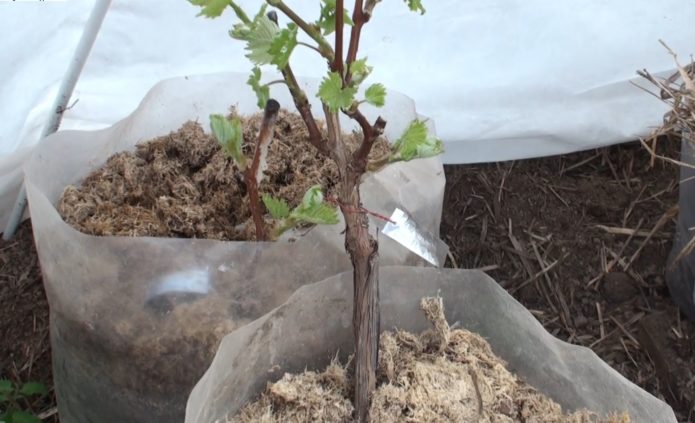
It hardly makes sense to use a greenhouse for growing several seedlings, but as a temporary, "staging" point, it will also work in amateur viticulture
After planting the cuttings, the sand must be watered with warm water so that it is constantly slightly moistened. The optimum temperature in the greenhouse is about 18 aboutC, and the sand in the root zone is about 23 aboutC, air humidity is about 75%. Under such conditions, the roots are well laid, and bud breakup is temporarily delayed.
After 2-3 weeks, leaves and root buds should appear at the same time. After another week, the cuttings are carefully transplanted into any containers of sufficient volume (large cups, cut plastic bottles, etc.). It is desirable that by this time the roots of the branch are at least up to 2 cm. The best soil composition for planting tanks is sod soil, compost and sand (approximately 40: 40: 20%). In the future, a high temperature is needed, at least 25 aboutC, and good lighting.
It takes about 2 months from planting in a container to transplanting seedlings to a permanent place. In May, it is necessary to accustom future seedlings to fresh air, opening windows and doors of the greenhouse for a while. At this time, if the shoots have grown from several buds, only one, the most powerful, is left. If it grows too long, then when it reaches a height of half a meter, the top is pinched to it: for planting in open ground, the main shoot should not be long, but strong, let it continue to grow in thickness.
Planting cuttings in open ground
In the southernmost regions of our country, it is possible to plant cuttings directly in open ground. Moreover, this is often done even in the fall, immediately after cutting the cuttings, and good results are obtained. When planted in autumn, the cuttings root well and grow in spring with the onset of warm weather. In autumn, the stalk is completely buried in the ground, leaving only one bud on the surface. But for the winter they huddle it too, and cover the bed with a film and sprinkle it with a layer of earth. In the spring, the structure is opened, a hole is cut in the film for the escape. The stalk is uncooked only when the grapes are clearly growing and there is a steady heat.
Spring planting of cuttings in open ground is possible when the soil at a depth of 10 cm warms up to 10-12 aboutC, in the south, this time falls on March. Processing of cuttings before planting is standard, keeping cuttings in a jar of water or wet sawdust is mandatory, at least before the roots begin to grow back.
Cuttings are planted in well-fertilized soil to a depth of 40 cm: since this is open ground, you do not need to limit yourself to the size of the cuttings, they can have more than 3 buds so that the roots will immediately grow powerful. Cuttings are planted with a slight slope, leaving two buds on the surface. If it's still cool, you can temporarily cover them with non-woven materials.
Features of cultivation in different regions
In the case of grapes, the process of growing the planting material varies greatly depending on the climatic conditions of the region. If in the southernmost regions they are rarely associated with the cultivation of seedlings at home, then in the north it cannot be otherwise.
Districts of the Kuban, including the Krasnodar Territory
In Russia, over half of the grapes are grown in the Krasnodar Territory. The main wine-growing regions are Temryuk, Anapsky, Krymsky, the cities of Novorossiysk and Gelendzhik. The climate of the Krasnodar Territory is the best suited for viticulture. The weather conditions are slightly different in other regions, territories and republics of the Kuban region. It is quite warm everywhere here, only the amount of precipitation in certain areas can vary greatly. The soil is fertile, there is a lot of light, and this makes it possible to get rich harvests of grape berries.
The basic rules for planting in the Kuban do not differ from the usual norms, but seedlings are almost never grown here in a city apartment.
Most often, cuttings are planted directly in open ground, and the "long vine" option is often practiced: in the fall, a piece of vine about one and a half meters long is immediately buried in a large planting hole, twisting it into a spiral and leaving 1-2 buds on the surface. For successful root formation in this option, an irrigation pipe is carried out into the zone of future roots, but a large drainage layer is necessarily arranged.
The soils in many regions of the Kuban are so good that many amateurs do not even dig planting holes, but plant cuttings in the fall “under the ramrod”. This is what they call the technique of making mini-holes with heavy metal scrap. It punches holes 10–12 cm wide and 10–15 cm deeper than the length of the cutting. Fertilized soil is poured onto the bottom of the well (only half a bucket!), A long handle is inserted, the soil is tamped, watered well, the well is filled so that there are no voids left, and they wait for a result that is close to 100% success.
Belarus
Previously, Belarus was not considered an area suitable for viticulture, but those times are long gone: now grapes on personal plots are a common thing, although it requires the application of strength and skills. The climate in the country is quite mild, although not very hot; many grape varieties have time to ripen successfully. But the cultivation of seedlings from cuttings is almost always carried out at home, in extreme cases - in a greenhouse, usually heated.
Planting cuttings for cultivation begins here at the usual dates indicated above - at the very end of winter. They use a variety of methods of germination, but they do it without fail: almost no one plants cuttings without roots. There is a lot of peat in Belarus, so they try to add it to any soil, and soil for growing grape seedlings is no exception: the most popular mixture is peat with sand and a small amount of sod land. All other operations are completely similar to those described in the main part of this article.
Moscow suburbs
The climate of the Moscow region is very similar to that of Belarus, but more unpredictable, although this refers to the winter period, when severe frosts alternate with unexpected thaws. Therefore, viticulture is a little more risky here, but this mainly concerns the shelter of adult bushes for the winter and the right choice of grape varieties: it is somewhat limited.
As for the cultivation of seedlings from cuttings, it is carried out in the same way as described above, with a slight shift in timing: cuttings are taken out of storage in early spring. Their germination for the formation of root rudiments is mandatory, cuttings with roots are planted in a container with soil composed of a mixture of peat and coarse sand. Cuttings are kept in containers a little longer than in Belarus, and planted in a permanent place closer to mid-June.
Video: grapes from cuttings in the Moscow region
Ural region
Well, who would have thought half a century ago that grapes could be grown in the Urals? Now you can, however, not any varieties, but only the most frost-resistant. You can also grow planting material from cuttings, and this is no more difficult to do than in the middle zone of the European part of Russia. True, the timing is somewhat different here.
Planting cuttings at home is carried out in the same way as in the Moscow region, but they are not planted in June in open ground, but they are grown all summer: first in greenhouses or greenhouses, and from July in the open air. If the growth proceeds powerfully, in the summer the plant is gently transferred into deeper containers (old buckets).
By autumn, planting holes are dug and before the onset of frost (and often already in September), grown seedlings are deeply planted in them, if they already have at least two well-ripened buds. When planting, only one bud is left on the surface, and it is spud and well covered for the winter.
Reviews
For difficult-to-root varieties - honey can be used if there is nothing better. It still gives a small effect. Two tablespoons of honey, the same for 20 liters of water, can be rooted about a thousand cuttings (after all, we only wet the heels). And if you need a couple of dozen, 1/4 teaspoon of honey is enough for 1 liter of water. These are small costs. Large doses of honey can also have the opposite effect (like other stimulants).
First, you should prepare your own, not purchased soil, since that soil (peat) that is sold in stores has many pathogenic bacteria and the roots in such soil rot. The soil (soil) should be as poor as possible, air-capacious, not rich in nitrogen, approximately: 40% coarse, white, washed sand, + 40% light leafy soil (taken in the fall in plantings under leaves, a layer of 5 cm and there is leafy soil) , + 20 percent of steamed sawdust mixed with activated carbon (10 tablets of crushed coal per 0.5 liter volume). All this mixture is mixed and used for planting cuttings with short white roots extracted from the kilchevator.
The main thing when rooting is patience, do not torment your cuttings, do not hang out from place to place. The rooting time is always different (from 2 weeks to 2 months) and depends on many factors. From the quality of the cutting, from the conditions that you created for him, from the variety, etc., etc. (you will not take into account everything). Not least is your patience. EXPRESS it ... and everything will be fine.
For planting grapes on the site, the easiest way, of course, is to buy a ready-made seedling. Sometimes it turns out not more expensive than going all the way from cutting to sapling in a city apartment. But self-cultivation is not only work, but also a great pleasure, especially in case of success. Therefore, most amateurs try to grow grape seedlings from cuttings themselves, and although it is not easy to do this, it is quite possible.
